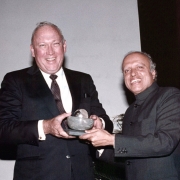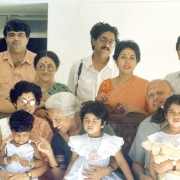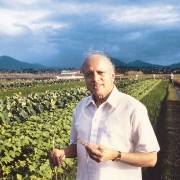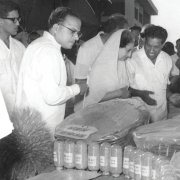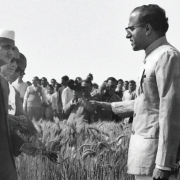
People
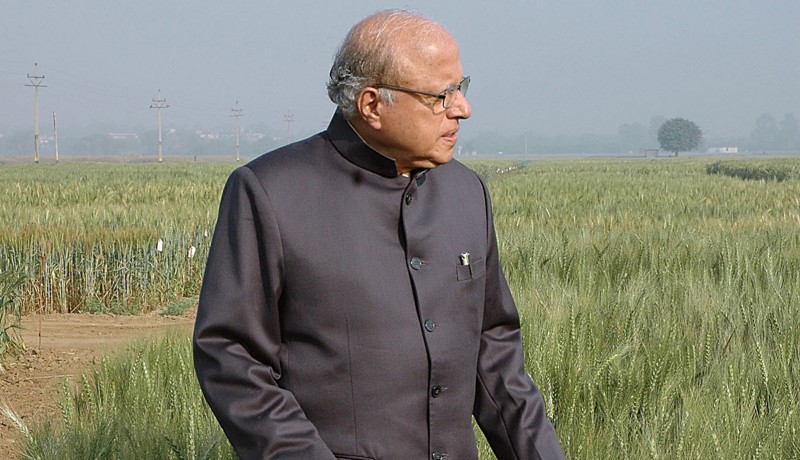
Architect of the Green Revolution in India M S Swaminathan is not just an advocate of sustainable development but an eco-warrior with his heart in the right place, writes Srirekha Pillai
It’s the path we take that decides where we end up. When Monkombu Sambasivan Swaminathan, better known as M S Swaminathan, decided to chuck medical studies to pursue agriculture, it was to have a far-reaching impact not just on his life but that of an entire nation. India’s agricultural landscape owes its revival in no small measure to this scientist’s ingenuity and insight.
Born as the second son of surgeon M K Sambasivan and Parvati Thangammal Sambasivan of Kumbakonam, Tamil Nadu, in 1925, Swaminathan was seamlessly drawn into the warp and weft of Gandhian ideology that permeated a country struggling to break free of foreign shackles. He grew up seeing his father taking the lead in opening the temples in Kumbakonam to Dalits and burning foreign clothes. However, the turning point was the Bengal famine of 1943, in which over 3 million people died. The scale of the tragedy moved Swaminathan so much that he decided to pursue agricultural research and address the food security concerns of India. Recalling that moment, he tells Harmony Celebrate Age, “We were young and idealistic and wanted to serve
the nation.”
With the lofty intention of wanting to rid the world of hunger and poverty, he joined the Indian Agricultural Research Institute in New Delhi, and later the Plant Breeding Institute at the University of Cambridge. On his return to India, Swaminathan heralded the Green Revolution by introducing Mexican semi-dwarf wheat plants and high-yield varieties of rice, besides popularising modern farming methods. His pioneering efforts transformed India from a food-deficit nation into one of the leading producers and exporters of food grains in the world. Over the years, Swaminathan has worked in collaboration with scientists and policymakers to leave an indelible mark on food security concerns in India and elsewhere in the developing world. Little wonder then, that he was recognised by TIME magazine in 1999 on the ‘TIME 20’ list of Most Influential Asian People of the 20th Century. The only other Indians to figure on the list were Mahatma Gandhi and Rabindranath Tagore.
Another measure of the life-changing impact of his work is the statement of then UN secretary general Javier Perez de Cuellar, who said while presenting the First World Food Prize to Swaminathan in 1987, “He will go into the annals of history as a world scientist of rare distinction.” His work was further acknowledged when the UN Environment Programme termed him the “Father of Economic Ecology”. Recently, Swaminathan was also honoured with the Canadian Governor General’s Medallion in recognition of his contribution to “improved agricultural practices and rural development in India and abroad”.
Not one to rest on his laurels, the 91 year-old still pursues his life’s mission by guiding young agricultural scientists and hobnobbing with policymakers. Recently, when Delhi choked with smog created by the burning of paddy straw in neighbouring states, he recommended to Prime Minister Narendra Modi that we commercialise straw by turning it into animal feed, cardboard, paper and other products. On a trip to Delhi, he also prevailed upon visiting Malaysian Prime Minister Najib Razak the need to reserve some land for traditional farming. “Malaysia has been investing in plantation crops such as rubber, cocoa and palm as they generate a high income for farmers,” he says. “But they need to cater to their food needs as well.”
Swaminathan is married to renowned educationist Mina, whom he met in Cambridge in 1951. The couple has three daughters—Soumya, director-general of the Indian Council of Medical Research, Delhi; Madhura, professor of economics at the Indian Statistical Institute, Bengaluru and the “first woman Rhodes scholar in Oxford from India”; and Nitya, senior lecturer in gender analysis and development at the University of East Anglia, Norwich—and five grandchildren. We met the architect of the Green Revolution, who is also the founder-chairman of the M S Swaminathan Research Foundation, at his office in Chennai, where he was busy juggling professional commitments and interview requests before rushing home to his indisposed wife.
EXCERPTS FROM AN INTERVIEW
India is moving from an agrarian society to urbanisation. What are the immediate and long-term dangers of this?
Urbanisation is part of evolution. The US was completely agrarian at the time of the arrival of the Pilgrim Fathers but is 98 per cent urban now. There’s nothing wrong with urbanisation per se. However, urban planning is important. While planning cities, factors such as food and drinking water sources, provision of jobs and climate security need to be addressed. Food is the first among the hierarchical needs of a human being. With a massive population such as ours—130 billion at last count—we have to do some serious thinking. Our former president A P J Abdul Kalam advocated Provision of Urban Amenities to Rural Areas (PURA). If we have facilities such as schools, colleges, hostels, hospitals and jobs in rural areas, we can check unplanned migration from villages. Urbanisation and globalisation should not be at the expense of food and nutritional security.
Climate change is a reality today with India frequently experiencing bad monsoons and drought. How do we tackle this?
Climate change is a global phenomenon. As a result of global warming, temperatures are increasing, sea levels are rising and coral reefs are getting destroyed. One of my granddaughters, who studies coral reefs, is saddened by the damage done to them. Every country needs to be involved in mitigation and adaptation. While mitigation helps in reducing greenhouse emissions, adaptation requires adopting a lifestyle that does not exercise a huge demand on land, agriculture, water and so on. We have a great responsibility to ensure that we do not damage the ecosystem any further.
Would you say that we are selfish when it comes to preserving our ecosystem?
It’s sad that we quite often don’t take a broader view. For instance, US President Donald Trump has been pursuing policies that damage the ecology, saying that Americans won’t be affected by climate change. He is forgetting that Americans coexist with billions of others. When we talk of environment, we should talk of the common good, which will eventually contribute to individual good.
Incidentally, our ecosystems were defined in Sangam literature—ancient Tamil literature spanning 300 BCE to 300 CE—about 2,000 years ago. There is mention of hill zone, coastal zone, arid zone, semi-arid zone and wet zone. Our ancestors had the wisdom to differentiate ecosystems and chalk out management strategies for each of them.
You’ve said rice is going to be the crop of the future. What makes it so?
With over 150,000 varieties, rice is definitely the crop of the future. What makes it the climate saviour crop in an era of climate change is that it’s more flexible in terms of altitudes, latitudes and temperature. You can grow rice below sea level and even on high altitudes like the Himalaya. Rice grows well in Srinagar as well as in Kuttanad [Kerala]. We have such a huge variety of gene pool in rice. None of the other crops can do that as they are sensitive to temperature and other factors.
Should we be investing in less water-intensive crops?
Given the scarcity of water resources, that’s the most practical way forward. I have been advocating more-crop-a-drop methodology. We should use drip and sprinkle irrigation to cut down on water shortage. It’s unfortunate that we only think about supply augmentation, without giving any thought to resource management, an important part of sustainable development.
Being an agricultural scientist, are you conscious about what features on your platter?
I’m very conscious about what I eat, both for taste and nutritive values. Traditional methods of agriculture, including the use of cow dung and urine to increase the fertility of the soil, are a great way to ensure healthy food. We have to remember that the output is equivalent to the input. What goes into the soil determines what comes out. The Gloria Land farm at the Sri Aurobindo Ashram in Pondicherry is one of the best organic farms in India.
Your father M K Sambasivan seems to have been a great influence on you.
My father was a true Gandhian. I imbibed a lot from him, particularly the concept of Swadeshi or self-sufficiency. He told me that nothing was impossible. He would say that the word ‘impossible’ existed only in our minds, and with discipline and hard work we could achieve anything. He eradicated filariasis [roundworm infection] in Kumbakonam by mobilising people to remove breeding grounds of mosquitoes. He led the opening of temples to Dalits in Kumbakonam. The fight against hunger became my mission and obsession, thanks largely to his influence.
You took admission to a medical school but dropped out, opting for agriculture instead.
My father died when I was only 11 years old. My mother was keen that I take over his hospital in Kumbakonam. I was in a dilemma; I wanted to contribute to independent India in the best way possible. I had two options: become a doctor and run my father’s hospital or revolutionise agriculture in the country. I chose the latter.
How did Gandhian principles influence you as a youngster?
I was influenced by my parents’ value system. Most often, we get influenced more by non-verbal communication than verbal communication. As I mentioned, my father’s Gandhian principles influenced me in a major way. Similarly, I grew up watching my mother, a very simple lady, spinning her saris from home-grown cotton. That image has stayed with me.
Tell us about your wife.
Mina is an educationist. Her areas of interest are education, gender and early childhood care. She did a master’s in economics from Cambridge Newnham College, a college for women. When she returned to India, she joined as an advisor to the Planning Commission. Later, as a teacher at St Thomas’ School in Delhi, she developed educational methodologies using drama as a means of communication. She’s the author of Integrated Child Development Services (ICDS), an anganwadi programme for providing food, preschool education and primary healthcare to kids.
Where did you meet her?
I met her in Cambridge in 1951. I wouldn’t say we knew each other. Later, while working in Delhi, we met a few times and realised we shared certain values. That brought us together.
What are your cultural and leisure pursuits?
I enjoy Carnatic music, Bharatanatyam and reading. My wife is a very good pianist and enjoys Western classical music. Earlier, I used to play tennis and hockey. I was also an avid swimmer. Now, swimming is reserved for those few occasions when my grandchildren come calling and force me to accompany them.
What are your thoughts on ageing?
I will be turning 92 soon. Being a scientist, I can’t expect body cells to work the way they did when I was younger. Old age takes a different form in different people. Thankfully, my brain is functioning well. However, I’ve developed weak cartilages, and over the years have struck up a close friendship with my walking stick.
CAREER GRAPH
- Director, Indian Agricultural Research Institute (1961-72)
- Director General, Indian Council of Agricultural Research (1972-79)
- Principal Secretary, Ministry of Agriculture and Irrigation, Govt of India (1979-80)
- Member, Planning Commission and Chairman, Scientific Advisory Committee to Cabinet, Govt of India (1980-82)
- Independent Chairman, Food and Agriculture Organization (FAO) Council (1981-85)
- Director General, International Rice Research Institute, the Philippines (1982-88)
- President, International Union for the Conservation of Nature and Natural Resources (1984-90)
- President, World Wide Fund for Nature, India (1989-96)
- President, National Academy of Agricultural Sciences (1991-96; 2005-07)
- Chairman, National Commission on Farmers of India (2004-06)
- President, Pugwash Conference on Science and World Affairs (2002-07)
- Member, Rajya Sabha (2007-13)
- Chairman, M S Swaminathan Research Foundation (MSSRF) (1988 onwards)
- UNESCO Cousteau Chair in Ecotechnology (1994 onwards)
AWARDS APLENTY
- Shanti Swarup Bhatnagar Prize (1961)
- Padma Shri (1967)
- Ramon Magsaysay Award (1971)
- Padma Bhushan (1972)
- Albert Einstein World Award of Science (1986)
- Padma Vibhushan (1989)
- World Food Prize (1987)
- Tyler Prize for Environmental Achievement (1991)
- UNESCO Gandhi Gold Medal, France (1999)
- Volvo Environment Prize (1999)
- Indira Gandhi Prize for Peace, Disarmament and Development (1999)
- Franklin D Roosevelt Four Freedom Medal, Netherlands (2000)
- Mahatma Gandhi Prize, UNESCO (2000)
- Lal Bahadur Shastri National Award (2007)
- Shining World Leadership Award, Singapore (2007)
- Indira Gandhi Award for National Integration (2013)
- Canadian Governor General’s Medallion (2017)
THE AGRICULTURE FACTSHEET
- Vedic literature provides some of the earliest written record of agriculture in India. Rigveda hymns describe ploughing, fallowing, irrigation, fruit and vegetable cultivation
- Ploughing patterns from the Bronze Age have been excavated at Kalibangan in Rajasthan
- Rice was a domesticated crop along the banks of the Ganges in the sixth millennium BC
- Today, India ranks second worldwide in agricultural output
- Double monsoon leads to two harvests in a year
- The main food grain of India is rice. It ranks second worldwide in rice production
- India ranks fourth in wheat production in the world
- India is the largest producer of sugarcane in the world and the second largest producer of tea
- India is also the largest producer and consumer of dairy in the world. Milk production totals 140 billion litre a year
ONE FOR THE BOOKS
- Science and Integrated Rural Development (1982)
- Agricultural Growth and Human Welfare (1992)
- Sustainable Agriculture: Towards Food Security (1996)
- I Predict a Century of Hope Towards an Era of Harmony with Nature and Freedom from Hunger (1999)
- Groves of Beauty and Plenty (2003)
- Towards a Hunger-Free World (2006)
- Environment and Agriculture (2006)
- Revolutions: To Green the Environment, to Grow the Human Heart (2007)
- Science and Sustainable Food Security (2009)
- From Green to Evergreen Revolution: Indian Agriculture (2010)
- In Search of Biohappiness: Biodiversity and Food, Health and Livelihood Security (2011)
- Remember Your Humanity: Pathway to Sustainable Food Security (2012)
- Evergreen Revolution in Agriculture: Pathway to a Green Economy (2012)
- Halving Hunger: It Can Be Done (2013)
- Combating Hunger and Achieving Food Security (2016)
Photographs courtesy: M S Swaminathan Featured in Harmony — Celebrate Age Magazine June 2017
FORESTS
WILDLIFE
WATER
WASTE MANAGEMENT
ENERGY
SUSTAINABILITY
EXCLUSIVE COLUMN
EXCLUSIVE COLUMN
you may also like to read
-
For the love of Sanskrit
During her 60s, if you had told Sushila A that she would be securing a doctorate in Sanskrit in the….
-
Style sensation
Meet Instagram star Moon Lin Cocking a snook at ageism, this nonagenarian Taiwanese woman is slaying street fashion like….
-
Beauty and her beast
Meet Instagram star Linda Rodin Most beauty and style influencers on Instagram hope to launch their beauty line someday…..
-
Cooking up a storm!
Meet Instagram star Shanthi Ramachandran In today’s web-fuelled world, you can now get recipes for your favourite dishes at….



